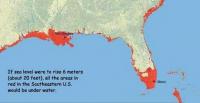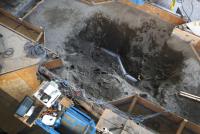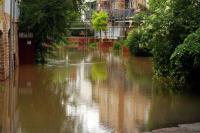-
False earthquake smartphone alert sends Japanese into panic
Thousands of Tokyo residents were sent into panic by an erroneous alert that a massive earthquake had hit the Japanese capital. The alert also disrupted some train services. The Japanese Meteorological Agency issued, and then sent, the alert just after 5 p.m., saying a magnitude-9.1 quake had struck the city. The agency cancelled the alert a few seconds later, but tens of thousands of smartphone owners who subscribe to the popular Yurekuru disaster warning app had already received the alert.
-
-
How to generate energy during earthquakes
Physics students from the University of Leicester have explored a feasible way to harness the power of earthquakes during a disaster in order to keep vital systems powered. By using a magnet inside a coil during the shaking of tectonic plates that occurs during an earthquake, the students suggest that the magnetic field created by the shaking could generate a current which could potentially be harnessed.
-
-
Fort Collins, Colorado, using NIST guide to bolster community resilience
Guided in part by strategies and procedures developed by NIST for creating effective and affordable community resilience, the city of Fort Collins, Colorado, is making a commitment to “deal with prospects of future weather- and climate-related challenges that put our community at greater risk,” according to Mayor Pro Tem Gerry Horak.
-
-
Electric grid vulnerabilities in extreme weather areas
Climate and energy scientists at the DoE’s Oak Ridge National Laboratory have developed a new method to pinpoint which electrical service areas will be most vulnerable as populations grow and temperatures rise. The scientists’ integrated approach – combining ORNL’s unique infrastructure and population datasets with high-resolution climate simulations run on the lab’s Titan supercomputer — identifies substations at the neighborhood level and determines their ability to handle additional demand based on predicted changes in climate and population.
-
-
Nuking asteroids to protect Earth

Scientists are developing measures to protect the Earth from potentially dangerous celestial bodies. With the help of supercomputer SKIF Cyberia, the scientists simulated the nuclear explosion of an asteroid 200 meters in diameter in such a way that its irradiated fragments do not fall to the Earth.
-
-
Sea-level rise threatens many coastal U.S. military bases

The U.S. Armed Forces depend on safe and functional bases to protect the U.S. national security. Sea levels are rising as global warming heats up the planet, and many military bases along the U.S. East Coast and Gulf of Mexico are at risk of permanently losing land to the ocean in the decades ahead. As the seas rise, high tides will reach farther inland. Tidal flooding will become more frequent and extensive. When hurricanes strike, deeper and more extensive storm surge flooding will occur. The United States must thus prepare for the growing exposure of its military bases to sea level rise.
-
-
Warmings greater than 1.5 °C inevitable owing to current atmospheric greenhouse concentrations
Current levels of atmospheric greenhouse gas concentrations already commit the planet to air temperatures over many land regions being eventually warmed by greater than 1.5°C, according to new research. The results of the new study have implications for international discussions of what constitutes safe global temperature thresholds, such as 1.5°C or 2°C of warming since pre-industrial times. The expected extra warming over land will influence how we need to design some cities. It could also impact on the responses of trees and plants, including crops.
-
-
Earthquake-resilient pipeline could allow Los Angeles’s water utility system withstand tremors

Los Angeles’s water utility system – the nation’s largest — crosses over thirty fault lines en route to supplying water to more than four million residents. A top engineer from the city of Los Angeles visited Cornell University this month as researchers tested a new earthquake-resilient pipeline designed better to protect southern California’s water utility network from natural disasters. The steel pipe uses a unique structural wave design to control buckling, allowing the pipe to bend and compress without rupturing or losing water pressure.
-
-
Flood-related losses in Germany to increase under climate change

Flood-related losses can be expected to increase considerably in Germany as a result of climate change, a new study shows. Extreme events like the severe floods along the river Elbe have already illustrated the potentially devastating consequences of certain weather conditions such as severe rainfall events, when continuing intense rain can no longer be absorbed by the soil and water levels in the rivers rise. Without appropriate adaptation, flood-related damage of currently about €500 million a year could multiply in the future, according to the comprehensive expert analysis.
-
-
Climate disasters increase risk of armed conflict in multi-ethnic countries
Climate disasters like heat-waves or droughts enhance the risk of armed conflicts in countries with high ethnic diversity, scientists found. Each conflict is certainly the result of a complex and specific mix of factors, but it turns out that the outbreak of violence in ethnically fractionalized countries is often linked to natural disasters that may fuel smoldering social tensions.
-
-
New research predicts a doubling of coastal erosion by mid-century in Hawai’i
Chronic erosion dominates the sandy beaches of Hawai’i, causing beach loss as it damages homes, infrastructure, and critical habitat. Researchers have long understood that global sea level rise will affect the rate of coastal erosion. Newresearch team developed a simple model to assess future erosion hazards under higher sea levels.
-
-
Cape Cod susceptible to potential effects of sea-level rise
Cape Cod is vulnerable to rising water tables and, in some areas, groundwater inundation as a result of rising sea levels, according to a new U.S. Geological Survey study (USGS). Groundwater inundation occurs when the water table reaches or exceeds land surface. The challenges associated with the issue are likely to become more prevalent as seas rise. Depending on the severity, it may make areas unsuitable for residential and commercial development.
-
-
NIST leads federal effort to save lives, property from windstorms

Congress recently designated NIST to be the lead agency for the National Windstorm Impact Reduction Program (NWIRP). In one of its first actions as lead agency, NIST has announced in the Federal Register that it is establishing a panel of external experts to “provide advice on windstorm impact reduction and represent related scientific, architectural and engineering disciplines.”
-
-
Breaking records: The first six months of 2016 the warmest half-year on record
Two key climate change indicators — global surface temperatures and Arctic sea ice extent — have broken numerous records through the first half of 2016. While these two key climate indicators have broken records in 2016, NASA scientists said it is more significant that global temperature and Arctic sea ice are continuing their decades-long trends of change. Both trends are ultimately driven by rising concentrations of heat-trapping carbon dioxide and other greenhouse gases in the atmosphere.
-
-
What do climate tipping points mean for society
The phrase “tipping point” passed its own tipping point and caught fire after author Malcolm Gladwell’s so-named 2000 book. It is now frequently used in discussions about climate change, but what are “climate tipping points”? And what do they mean for society and the economy? In a new study, scientists tackle the terminology and outline a strategy for investigating the consequences of climate tipping points. The authors recommend using the phrase “climatic tipping elements” to describe portions of the climate system that may be abruptly committed to major shifts as a result of the changing climate.
-
More headlines
The long view
The Surprising Reasons Floods and Other Disasters Are Deadlier at Night
It’s not just that it’s dark and people are asleep. Urban sprawl, confirmation bias, and other factors can play a role.
Why Flash Flood Warnings Will Continue to Go Unheeded
Experts say local education and community support are key to conveying risk.
